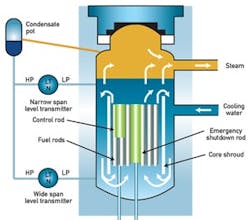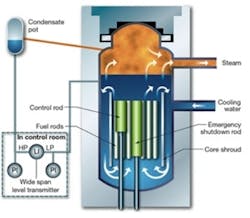The Traditional Reactor Level Measurement
Figure 1 shows the traditional method used in the majority of nuclear reactors. Here, the cooling water enters a jacket-like space between the shroud and the reactor wall and is pumped downward by a jet dispenser (not shown). It travels down "ex-core" (on the outside of the core) and then rises up "in-core." As it rises, the fuel rods heat it, and the water boils and, therefore, "swells."
Figure 1: This traditional system uses condensate pot compensated d/p transmitters. In such a system, if the condensate in the reference leg is lost (boils off), the level transmitters will over-report the level.
In most nuclear power plants, the ex-core level is measured by two differential pressure transmitters (Figure 1). One has a narrow span range (LT-N) and the other a wide one (LT-W). The narrow span transmitter (LT-N) is a better indicator of the surface of the boiling water, while the wide-range transmitter (LT-W) detects the total ex-core hydrostatic head (mass of water) in the reactor (the weight of the "collapsed water column").See Also: Help for Fukushima?
These level transmitters are installed with condensate pots which connect these reference legs ("wet legs") to the high-pressure side of the d/p cells. These level transmitters are "inverse-acting" (if the level rises, the transmitter output drops), because the hydrostatic head of the condensate in the reference leg is always higher than the weight of the water column inside the reactor. Therefore, the transmitter outputs are zero when the water level is at its maximum, and zero level generates a maximum output signal.
The reliability of this measurement depends on the assumption that the wet leg is full of condensate and that it is at ambient temperature. During an accident, these assumptions can be wrong because the condensate in the reference leg can overheat or drain. Even under normal operating conditions, the more bubbles that form (swelling), the higher will be the apparent actual level, but the lower its density and, therefore, the detectors will under-report the level. Inversely, as the steaming rate drops (shrinking phase), the density increases, and the actual level drops, while the level reported by the transmitters increases. Therefore, these level measurements are either unreliable or useless. The operators, after a while, notice that and start to disregard them or even disconnect the automatic level controllers and try to manipulate the level manually.
The Fukushima Design
In the case of Fukushima the design was even worse, because no transmitters were used at all. Only d/p indicators were provided, and they were located in the control room (Figure 2), requiring long lead lines. One of the lead lines detected the high-pressure reference from the condensate pot.
Figure 2: Direct-connected remote level indicators (LI) were used at Fukushima which further reduced reliability.
At Fukushima, soon after the cooling water pumps stopped, the condensate temperature in the uninsulated pot reached boiling point and boiled off. Once the lead line to the high pressure side of the level indicator emptied, the indicator over-reported the water level in the reactors by several meters, which gave the operators a false sense of security.See Also: The Fukushima Nuclear Accident - Part 1
Reliable Ex-Core Level Measurement
There are at least three ways to eliminate the level measurement error caused by the boiling off of the condensate from the wet legs. These are 1) Use different type level detectors; 2) Move the condensate pot, wet leg and d/p cell outside the primary containment; 3) Keep the existing system, but detect the height of the reference leg and if it drops, compensate for that drop.
Choices 1) and 2) requires plant shutdown, while 3) can easily be implemented without shutdown and without much expense (Figure 3).
Figure 3: This control system continuously calculates the correct level (CL) if during an emergency, some or all of the condensate has boiled off from the wet leg. Converting a traditional system (Figure 1) to this one is easy and does not require a plant shutdown.
Figure 3 shows how the actual weight of the (remaining) condensate in the wet leg (AWL) is measured and how that is subtracted from the normal reference wet leg (RWL). The calculated difference (ΔL) is the height of the lost condensate in the wet leg. Under emergency conditions, by adding this amount (ΔL) to the level reported by the d/p cell (NL), the corrected level (CL) is obtained. It is recommended that both signals (NL and CL) be sent to the control room to provide the operators with the needed information concerning the conditions in the reactor. Any number of d/p cells (LT) can be added to the reactor, and the closer they are vertically, the more accurate their readings will be. In addition to reporting the level, they can also measure trends and other variables, such as the steam-to-water ratio, etc.See Also: Inside Fukushima and Preventing Future Disasters
In-Core Level Measurement
The ex-core level measurement will approximate the in-core level only so long as the fuel rods are covered by water, but once the ex-core level drops below the suction of the jet diffusers, it will not. Therefore, direct in-core measurement is also needed. In many cases, such as Fukushima, they were not provided.
One method of in-core level measurement is to correlate it with the gamma radiation distribution inside and outside the reactor. The vertical gamma radiation distribution is related to water level, because water is more of a moderator than steam. On the other hand, because gamma radiation is also a function of the neutron flux and of the speed of water recirculation, special correction models and algorithms are needed to obtain the water level from gamma radiation distribution.
Other possible ways to detect in-core level (or steam/water ratio) are based on the thermal or electric conductivity, or neutron modulation, etc. differences between water and steam.
Dr. David Nyce designed such a thermal conductivity-based, in-core level sensor for the Knolls Atomic Power Laboratory. In that design, a number of different length metal probes are inserted, each equipped with two vertically separated thermocouples (TC). The one located at the tip is heated, while the second, unheated reference thermocouple is a few inches above the tip. In the case of this sensor, if water covers both TCs, the temperature difference (ΔTw) will be lower than the temperature difference (ΔTs) when both are covered by steam.
See Also: Preventing Nuclear Accidents by Automation -- Part 2
If all nuclear power plants used the correct level measurement design shown in Figure 3, their safety would be much improved. In the next article in this series, I will describe other ways automation could have prevented the Fukushima accident.








